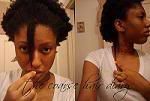 Excerpt from:
Excerpt from:Black Hair, Still Tangled in Politics
by Catherine Saint Louis
For many people no matter their race or hair texture, accepting yourself “as you are” is a high bar. The history of beauty is one of dissatisfaction and transformation: brunettes become blondes; white women get their curly hair Japanese-straightened. To go from short to shoulder-length and back again, celebrities from Britney Spears to Queen Latifah use weaves, which require a stylist to sew or to glue someone else’s hair into tracks on the scalp.
So why, asks Brian Smith, who runs TreasuredLocks.com with his wife, Tywana, is a hairstyle a “political or social statement” primarily among African-Americans? He has had customers implore him to stop giving hair-care advice to people who use relaxers because “you’re helping these women sell out.” But he and his wife, who now twists her hair herself after years of relaxing it, don’t take sides.
 The term “natural” is itself problematic, said Professor Banks, the author of “Hair Matters: Beauty, Power, and Black Women’s Consciousness.” She recently spent 14 months in black-centric salons in five cities researching a future book. Natural hair salons don’t offer chemical straightening or weaves. But she found “a great deal of coloring in natural hairstyling, thereby challenging the ‘chemically free’ label.”
The term “natural” is itself problematic, said Professor Banks, the author of “Hair Matters: Beauty, Power, and Black Women’s Consciousness.” She recently spent 14 months in black-centric salons in five cities researching a future book. Natural hair salons don’t offer chemical straightening or weaves. But she found “a great deal of coloring in natural hairstyling, thereby challenging the ‘chemically free’ label.”Oddly, Patricia Gaines, the founder of Nappturality.com, a pro-natural Web site, points out that dyeing one’s Afro puffs or double-strand twists blond isn’t viewed as conforming to a Euro-centric look. “It’s never been about color with black women,” she said, referring to the tint of one’s hair. “If it’s blond hair and it’s nappy, it’s still nappy.” (A term she uses proudly, though some use it as a slur.)
Read the full article...









 Product Name: Oyin Handmade Greg Juice
Product Name: Oyin Handmade Greg Juice













3 comments
August 27, 2009 at 4:28 PM
Although I'm Natural, I have nothing against those who use the 'creamy crack' How we wear our hair is a choice. But for those who's hairstyle was chosen for them when they were kids, I suggest they try the opposite of their hairstyle.
August 30, 2009 at 5:06 PM
My hair is permed now but i've gone natural and I had the idea to go dread but my preference is straight. I am not selling out.. Women use make up, black women with natural hair use makeup and other self enhancing things... At the end of the day it boils down to preference
September 1, 2009 at 10:12 AM
Not to be a stickler, but you really should include a source. Even though there is a link to read the full article, the reader has no idea it was published in the New York Times.
Post a Comment